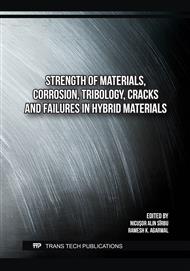[1]
J.C. Rowlands. Corrosion of tube and pipe alloys due to polluted seawater. (Journal of Applied Chemistry, 1965), pp.57-63.
DOI: 10.1002/jctb.5010150201
Google Scholar
[2]
D. Birchon. The use and abuse of materials in ocean engineering. (Proceedings of the Institution of Mechanical Engineers, 1970), pp.241-271.
DOI: 10.1243/pime_proc_1970_185_034_02
Google Scholar
[3]
Food and Agriculture Organization of the United Nations. Global record of fishing vessels, refrigerated transport vessels and supply vessels. (2025).
Google Scholar
[4]
D. Escudero. Materiales compuestos. Aplicaciones. (Informes De La Construcción, 2001).
DOI: 10.3989/ic.2001.v52.i472.676
Google Scholar
[5]
A.C. Omaña, J.M. Arenas, J.C. Suárez (2022). Analysis of the behavior of fiberglass composite panels in contact with water subjected to repeated impacts. (Polymers, 2002), p.4051.
DOI: 10.3390/polym14194051
Google Scholar
[6]
L. Bian, J. Xiao, J. Zeng, & S. Xing. Effects of seawater immersion on water absorption and mechanical properties of GFRP composites. (Journal of Composite Materials, Thousand Oaks, 2012), pp.3151-3162.
DOI: 10.1177/0021998312436992
Google Scholar
[7]
D.B. Dittenber. Evaluation of a life prediction model and environmental effects of fatigue for glass fiber composite materials. (Structural Engineering International, 2010), pp.379-384.
DOI: 10.2749/101686610793557753
Google Scholar
[8]
R.A. Shenoi, P.J. Read, G.L. Hawkins. Fatigue failure mechanisms in fibre-reinforced plastic laminated tee joints. (International Journal of Fatigue, 1995), pp.415-426.
DOI: 10.1016/0142-1123(95)98238-x
Google Scholar
[9]
M.A. Herreros, J.C. Suárez, M.P. Pinilla, S.M. Alonso, F. López, I.D. de Ulzurrun. MaLECoN: un nuevo material híbrido laminado fibra-metal para construcción naval. (47° Congreso de Ingeniería Naval e Industria Marítima, Madrid, 2008).
Google Scholar
[10]
J.C. Suárez, S. Miguel, I. Diez, P. Pinilla, M.A. Herreros, F. López. Modos de fallo en un material híbrido estructural para construcción naval: MaLECoN. (En Anales de Mecánica de la Fractura, 2004), pp.350-355.
Google Scholar
[11]
F. López, I. Diez. Determinación de la energía de fractura adhesiva de uniones disimilares en materiales híbridos estructurales. (En Anales de Mecánica de la Fractura, 2004), pp.186-190.
DOI: 10.20868/upm.thesis.83915
Google Scholar
[12]
K.C. Shin, J.J. Lee, K.H. Kim, M.C. Song, J.S. Huh. Axial crush and bending collapse of an aluminum/GFRP hybrid square tube and its energy absorption capability. (Composite Structures, 2002), p.279, 287.
DOI: 10.1016/s0263-8223(02)00094-6
Google Scholar
[13]
S. Boria, A. Scattina, G. Belingardi. Axial crushing of metal-composite hybrid tubes: experimental analysis. (Procedia Structural Integrity, 2018), pp.102-117.
DOI: 10.1016/j.prostr.2017.12.012
Google Scholar
[14]
G. Zhu, J. Liao, G. Sun. Comparative study on metal/CFRP hybrid structures under static and dynamic loading. (International Journal of Impact Engineering, 2020).
DOI: 10.1016/j.ijimpeng.2020.103509
Google Scholar
[15]
H. Yang, H. Lei, G. Lu. Energy absorption and failure pattern of hybrid composite tubes under quasi-static axial compression. (Composites Part B: Engineering, 2020).
DOI: 10.1016/j.compositesb.2020.108217
Google Scholar


